 |
|
CISS scores could determine if a child has oculomotor dysfunction, but it cannot diagnose accommodative insufficiency. Photo: Jasleen Jhajj, OD. Click image to enlarge. |
Patient questionnaires can be quite useful in several spheres of practice, helping clinicians to elicit and document information that might not be obvious during the time constraints of an exam. However, a new study cautions against overreliance on one used in binocular vision disorders.
Researchers recently assessed the application of the Convergence Insufficiency Symptom Survey (CISS) in quantifying symptoms of accommodative insufficiency and oculomotor dysfunction in children aged nine to 18 years. While the survey distinguished children with oculomotor dysfunction from those with normal binocular vision, it was unable to distinguish children with accommodative insufficiency based on symptoms.
A total of 82 participants were qualified for the study, with 18 in the normal binocular vision group, 21 in the accommodative insufficiency group, 16 in the oculomotor dysfunction group and 27 in the combined accommodative insufficiency and oculomotor dysfunction group.
Post-hoc tests showed significantly higher CISS scores in the oculomotor dysfunction group than the normal binocular vision and accommodative insufficiency groups, but no differences were detected among other groups. The researchers noted that the receiver operating characteristics curve showed a significant effect of the CISS score on predicting oculomotor dysfunction (Developmental Eye Movement test type II or IV). Using a CISS score of ≥15, good discrimination of the condition was obtained.
“Additional analysis showed an excellent negative predictive value of 80% in the use of CISS for oculomotor dysfunction, which means that 80% of normal binocular vision children identified by the CISS truly had normal binocular vision based on our sample,” the researchers noted. “Thus, the Convergence Insufficiency Symptom Survey is still a good test to identify the symptomatic oculomotor dysfunction children from those with normal binocular vision.”
Still, the team does not recommend the symptom survey for differential diagnosis of children with accommodative insufficiency.
Pang Y, Tan QQ, Gabriel H, et al. Application of the convergence insufficiency symptom survey in oculomotor dysfunction and accommodative insufficiency. Optom Vis Sci. 2021;98(8):976-82. |

